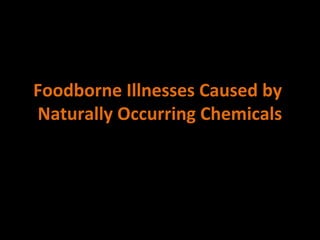Report
Share

Recommended
Recommended
More Related Content
What's hot
What's hot (20)
Chapter 1 (Occupational Health and Safety Hazards)

Chapter 1 (Occupational Health and Safety Hazards)
Chapter 2 Food Safety and Sanitation - Hazards to Food Safety

Chapter 2 Food Safety and Sanitation - Hazards to Food Safety
9th lecture-Sanitary procedures while preparing and cooking food

9th lecture-Sanitary procedures while preparing and cooking food
proper food handling, food safety, and sanitation practices

proper food handling, food safety, and sanitation practices
Viewers also liked
Viewers also liked (20)
Similar to Foodborne illnesses caused by
Similar to Foodborne illnesses caused by (20)
Toxicity from naturally occurring toxins in plant foods

Toxicity from naturally occurring toxins in plant foods
More from Bean Malicse
More from Bean Malicse (20)
Foodborne illnesses caused by
- 1. Foodborne Illnesses Caused by Naturally Occurring Chemicals
- 2. Food Allergens Cause the immune system to overreact • Symptoms: Hives, swelling of the lips, tongue and mouth, difficulty in breathing, vomitting, diarrhea and cramps. • Common Food Allergens: • Milk, soy, egg, fish, wheat protein, shellfish, peanuts, chicken
- 3. Ciguatoxins • Symptoms: • intoxication caused by nausea, vomiting, eating contaminated diarrhea, dizziness, tropical reef fish. shortness of breath • The toxin is found in • Common Foods algae and then eaten by reef fish, which is eaten Barracuda, mackerel, by big fish such as snapper, triggerfish barracuda, mahi mahi , bonito, jack fish, • Prevention : Toxin snapper, in which the is not destroyed by toxin is accumulated in cooking. Purchase sea the flesh of these fishes. foods from Reputable supplier
- 4. Scombrotoxin • called ‘histamine” poisoning, caused by eating food high in a chemical compound called “histamine” which produced by certain bacteria. • Leaving fish at room temperature usually result in histamine production.
- 5. Scombrotoxin • Symptoms : dizziness, burning sensation, facial rash, shortness of Breath, peppery taste in the mouth. • Common Foods : tuna, anchovies, blue fish, mackerel, amberjack, Dark meat fishes. • Prevention : Purchase food from reputable supplier, Store “fresh” sea food at Temperature between 32⁰F (0⁰C)-39⁰F • Do not accept seafood that is suspected being thawed and Refrozen or temperature abused.
- 6. Shellfish Toxin • toxins are produced by certain algae called “ dinoflagellates” when eaten by certain shellfish such as mussles, clams, oysters, Scallop accumulate in their internal organs and become Toxic to humans. • Common Foods : Mussel, clams, oysters, scallop • Prevention : Purchase shellfish from reputable supplier
- 7. Mycotoxins • Fungi are molds, yeast and mushrooms, some of which are Causing food borne illnesses. Molds and yeast can withstand more • extreme condition than bacteria • Many mycotoxin have been shown to cause cancer. • “aflatoxin” is produced by certain mold
- 8. Amygdalin • (kernel) of apricots and peaches, that can turn into hydrogen cyanide in the stomach causing discomfort and illness.
- 9. Ipomeamarone • found in “kumara”, member of the sweet potato, results to injury, insect attack. That can result to bitter taste.
- 10. Furocoumarins • found in “parsnips” that can cause stomach ache, also cause a painful skin reaction.
- 11. Glycoalkaloids • found in all potatoes (particularly potato sprouts, green potatoes. That can result to abdominal pain, vomiting, diarrhea, convulsion, hallucination, paralysis, and occasionally death.
- 12. Lectins • found in beans (kidney, lima, peas). Raw kidney beans usually are toxic. (Do not cook beans at low temperature, soak beans for at least 5 hrs.)
- 13. Trypsin • found in raw soybeans. It cause depressed growth of rats, chicks)
- 14. Oxalic acid • found in “rhubarb”, cause muscle twitching, cramps, decreased breathing, vomiting, pain, headache, convulsions and coma.
- 15. Cucurbitacins • found in wild zucchini that can cause vomiting, stomach cramps, diarrhea and collapse. (Do not eat zucchini that have a strong unpleasant smell or bitter taste)
- 16. Cyanogenic Glycosides • found in cassava and bamboo shoots (raw or unprocessed cassava). • To avoid exposure to toxin, should be prepared before eating, cook cassava thoroughly
- 17. Goitrogen • found in cabbage, broccoli, cauliflower, canola, that can result to goiter. (they are lost by cooking)
